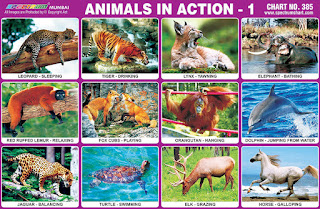 |
| Animals in Action 1 Chart |
Spectrum Chart - 385 : Animals in Action 1
1. Leopard (Sleeping) - Leopards are part
of the cat family. Leopards are well known for their cream and gold
spotted fur. A leopard’s body is built for hunting. They have
sleek, powerful bodies and can run at speeds of up to 57 km/h.
Leopards are mostly nocturnal, hunting their prey at night. Average
lifespan is between 10-15 years.
2. Tiger (Drinking) - Tiger is the biggest
species of the cat family. Tiger is the national animal of India.
Today the tigers are a near endangered species with only a handful
still roaming the Asian jungles. Average lifespan of tiger is 18 to
25 years.
3. Lynx (Yawning) - Lynx is a member of
the cat family. They have short stubby tails and the long tufts of
black hair on the ear. Lynx are usually solitary animals and will
spend their time both hunting and resting alone. Their lifespan
ranges between 12 - 20 years.
4. Elephant (Bathing) - Elephants are the
largest land-living mammal in the world. Elephants are herbivores and
can spend up to 16 hours days collecting leaves, twigs, bamboo and
roots. There are two species of elephant, the Asian elephant and the
African elephant. Lifespan of Elephants is 55 – 70 years.
5. Red Ruffed Lemur (Relaxing) – The red
ruffed lemur like all lemurs is native to Madagascar and occurs only
in the rainforests of Masoala in the northeast of the island. Its
soft, thick fur is red and black in colour and sports a buff or cream
coloured spot at the nape. Red ruffed lemur is mainly a fruit-eater,
though it is known to eat leaves and shoots. Red ruffed lemur is
listed as critically endangered.
6. Fox (Playing) - The fox is a scavenger
carnivorous dog. Foxes are characterised by sharp muzzle and fluffy
tail. Colour of the fur can be red, brown, black, grey, silver or
white. Tip of the tail is always white. Tips of their ears and feet
are always black. Fox is a nocturnal mammal. Fox tend to live for 6 –
7 years.
7. Orangutan (Hanging) - Orangutans are
large, red coloured Apes. They are the only group of Great Apes that
live outside the Africa. There are two types of orangutans: Sumatran
and Borean orangutans. Both species are critically endangered because
of poaching and loss of habitat. Orangutans are the largest arboreal
mammals. They are herbivore. 50% of their diet consists of fruit.
8. Dolphin (Jumping from Water) - Dolphins
are aquatic marine mammals part of the toothed whales. Dolphins are
from 1.5 to 4 metres long. Although dolphins are widespread, most
species prefer the warmer waters of the tropic zones. Dolphins feed
largely on fish and squid. Dolphins are often regarded as one of
Earth's most intelligent animals.
9. Jaguar (Balancing) - The jaguar is the
3rd largest of the big cats after the tiger and the lion. They are
only found in the Americas.They have a large, broad head with jaws so
strong that they are said to have the most powerful bite of all the
world's cats. Their lifespan in 12 – 15 years.
10. Turtle (Swimming) - Turtles are
reptiles having a hard shell that protects them like a shield, this
upper shell is called a ‘carapace’. Many turtle species can hide
their heads inside their shells when attacked by predators. Turtles
spend large amounts of their lives underwater.
11. Elk (Grazing) - Elk is large mammal
that belongs to the family of deer. There are over 10 subspecies of
elk that can be found in North America and Asia. Elk has long head
with large ears and massive body with thin legs and short tail. Elk
is herbivore. Elk can survive 8 to 12 years in the wild.
12. Horse (Galloping) - Horses are used by humans for the
working activities such as agriculture, transportation, sports events
etc. Many products are derived from horses including meat, milk,
hide, hair, bones etc. Domestic horses have average lifespan of
between 25 to 30 years.

No comments:
Post a Comment